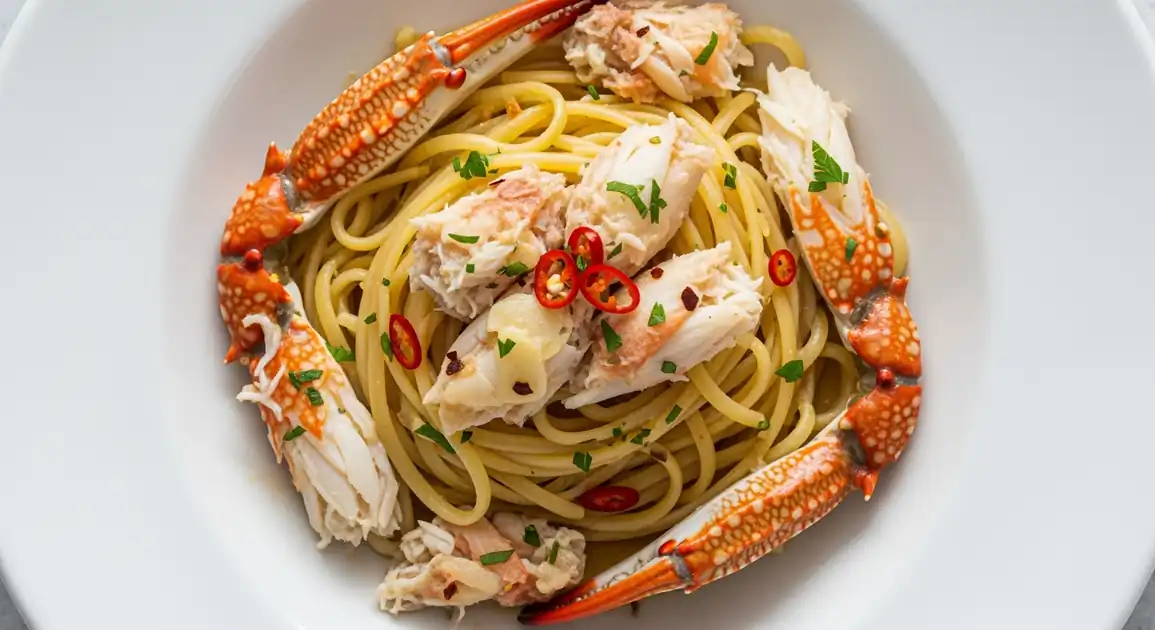Blue Swimmer Crab Linguine
Blue Swimmer Crab Linguine

Description
Blue Swimmer Crab Linguine appears on menus throughout Australia's coastal regions, often showcasing locally caught crab. The dish reflects Australia's embrace of its extensive seafood resources paired with Mediterranean culinary influences. While presentation and sauce styles may vary between regions, the emphasis on fresh, sweet crab meat remains consistent nationwide.
Dietary Information
Serving information
Serving style
Typically served in a wide, shallow bowl or plate to prevent the pasta from clumping. Usually garnished with fresh herbs and sometimes a lemon wedge on the side. Portion sizes tend to be moderate, focusing on quality over quantity.
Quick facts
Most restaurants serving this dish operate from 12 PM - 3 PM for lunch and 6 PM - 10 PM for dinner, with extended hours on weekends.
Safety Tips
What to Look For
-
Crab meat appears white and opaque
Properly cooked crab meat should be completely white or very slightly pinkish, never translucent or gray. Undercooked crab poses significant food safety risks.
-
Pasta is served steaming hot
Seafood dishes should be served at proper temperatures to prevent bacterial growth. A steaming plate indicates the dish has been freshly prepared and held at safe temperatures.
-
Clean, oceanic aroma without fishiness
Fresh crab has a sweet, oceanic smell. Any strong fishy or ammonia-like odors indicate the crab may not be fresh or has been improperly stored.
-
Visible chunks of crab meat throughout the dish
Quality versions of this dish showcase identifiable pieces of crab meat rather than tiny shreds or paste-like textures that might indicate lower quality or substitute products.
What to avoid
-
Strong fishy or ammonia smell
These odors indicate the crab is not fresh and could pose health risks. Fresh seafood should never smell strongly 'fishy' or like ammonia.
-
Gray or yellowish crab meat
Discolored crab meat may indicate spoilage or improper cooking. Properly cooked blue swimmer crab meat should be predominantly white.
-
Shell fragments mixed in with the pasta
Beyond being unpleasant to eat, shell fragments suggest hasty or careless preparation, which might indicate other corners being cut in the kitchen, including with food safety practices.
-
Pre-plated dishes sitting under heat lamps
Seafood pasta dishes should be made to order. Dishes kept warm for extended periods can develop food safety issues and significantly diminish in quality.
Price information
Price range
Budget tips
- Lunch specials often offer better value, with prices 15-20% lower than dinner service.
- Some restaurants offer half-portions at reduced prices.
- Seafood festivals may offer more affordable tasting portions.
- Restaurants in areas away from tourist centers often have better pricing for similar quality.
Value indicators
- Visible, generous chunks of crab meat throughout the pasta.
- House-made fresh pasta rather than dried (though both can be excellent).
- Mentions of locally sourced or sustainable crab on the menu.
- Seasonal specials often represent better value and fresher product.
- A light hand with the sauce, allowing the crab flavor to shine.
Where to Find This Dish
Coastal Areas
Restaurants with sea views often specialize in seafood pasta dishes using locally caught crab.
Beachfront promenades, Harbor fronts, Marina restaurants
Lunch, Early Dinner
Italian Precincts
Areas with strong Italian cultural influence often feature authentic interpretations of this fusion dish.
Little Italy districts, Historic Italian neighborhoods
Dinner
Upscale Dining Districts
Fine dining establishments throughout Australia offer sophisticated versions of this dish.
Central business districts, Upscale shopping areas
Dinner
Vendor Tips
- Ask where the crab is sourced from - specific regions like Spencer Gulf have excellent reputations.
- Check if the restaurant makes their pasta in-house, which often indicates greater attention to detail throughout the menu.
- Look for restaurants that mention sustainable seafood practices on their menus or websites.
How to Order
Regional Variations
-
Chili Blue Swimmer Crab Linguine
(Chili Blue Swimmer Crab Linguine)
A spicier version with a more generous amount of fresh or dried chili, sometimes incorporating nduja (spicy Italian pork paste) for additional heat and depth of flavor.
-
Creamy Blue Swimmer Crab Linguine
(Creamy Blue Swimmer Crab Linguine)
A richer variation that includes cream in the sauce, sometimes with a touch of tomato paste for color and flavor complexity. Often garnished with shaved parmesan cheese.
-
Blue Swimmer Crab and Prawn Linguine
(Blue Swimmer Crab and Prawn Linguine)
Combines both crab meat and local prawns for a more varied seafood experience, typically in the same light garlic and white wine sauce base.
-
Cherry Tomato Blue Swimmer Crab Linguine
(Cherry Tomato Blue Swimmer Crab Linguine)
Incorporates burst cherry tomatoes for acidity and sweetness, often with added fresh basil rather than just parsley.
-
Blue Swimmer Crab with Fresh Pasta
(Fresh Pasta Blue Swimmer Crab)
A premium version using house-made fresh pasta instead of dried linguine, offering a more delicate texture that pairs wonderfully with the sweet crab meat.
Cultural context
History
This dish reflects Australia's evolving food culture and the significant Italian immigration influence on Australian cuisine. Blue swimmer crabs have been harvested in Australian waters for generations, but their incorporation into pasta dishes gained popularity during the 1980s and 1990s as Australia developed its own distinctive fusion cuisine. In Melbourne specifically, the strong Italian community's culinary traditions merged with access to superb local seafood to create dishes like this. Today, it represents high-end Australian seafood cuisine that honors both Mediterranean techniques and local ingredients.
Local significance
The dish represents Australia's evolving food culture that embraces both quality local seafood and international culinary influences, particularly Mediterranean techniques. It showcases Australian seafood in a refined context.
Eating customs
- Typically eaten with just a fork, twirling the pasta to capture the sauce and crab meat together.
- Accompanying bread is often used to mop up remaining sauce - this is acceptable etiquette.
- The dish is meant to be savored slowly rather than rushed.